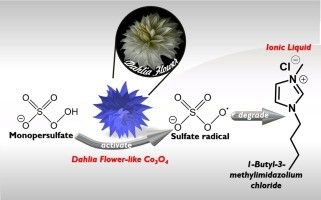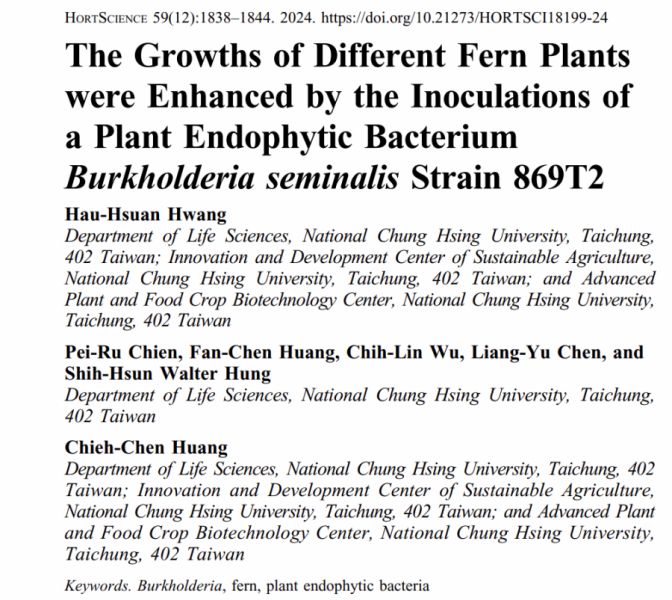循環農業:農業廢棄物高價值化【環境工程學系/林坤儀特聘教授】
| 論文篇名 | 英文:Degradation of an imidazolium-based ionic liquid in water using monopersulfate catalyzed by Dahlia flower-like cobalt oxide 中文:大麗花狀氧化鈷催化單過硫酸鹽降解水中咪唑鎓類離子液體 |
| 期刊名稱 | Separation and Purification Technology |
| 發表年份,卷數,起迄頁數 | 2021, 274,118668 |
| 作者 | Hsiao, Chia-Yu; Wang, Haitao; Kwon, Eilhann; Thanh, Bui Xuan; You, Siming; Hu, Chechia*; Lin, Kun-Yi Andrew(林坤儀)* |
| DOI | 10.1016/j.seppur.2021.118668 |
| 中文摘要 | 隨著基於咪唑鎓的離子液體 (IL)、1-丁基-3-甲基咪唑氯化物 (BMIMCl) 越來越多地用於各種應用,BMIM 陽離子釋放到環境中對水生生態構成了嚴重威脅。因此,從水中去除BMIM勢在必行,在各種去除BMIM的技術中,化學氧化是最有效的技術。然而,使用基於SO4自由基點的化學氧化方法降解BMIM的研究仍然非常有限。因此,本研究旨在開發一種有效的基於 SO4 自由基點的化學氧化工藝來降解BMIM。由於採用單過硫酸鹽 (MPS) 作為 SO4 自由基點− 的來源,因此通過將 Co3O4 製造成獨特的大麗花狀形態,提出並開發了一種特殊的鈷 (Co) 基催化劑。這種大麗花狀Co3O4(DFCoO)不僅可以呈現出花朵的形態,而且其花瓣成分可以由許多絲狀Co3O4納米結構組成,使得這種DFCoO與傳統的Co3O4納米顆粒(NP)相比具有多種優勢,包括更高的氧化還原活性、更多的反應性表面、更高的表面積和更大的孔體積。因此,DFCoO 顯示出比Co3O4 NP 高得多的催化活性,以激活 MPS 降解BMIM。較高的 MPS 劑量和反應溫度也會增強 DFCoO MPS 對BMIM 的降解。 DFCoO 可重複用於激活 MPS 以在多個週期內降解BMIM。通過鑑定自由基種類和降解中間體,還闡明了這種 DFCoO MPS 的BMIM 降解機制和途徑。該研究的結果為開髮用於 BMIMCl 硫酸鹽基降解的有利催化劑提供了一種有用的方法。 |
| 英文摘要 | As the imidazolium-based ionic liquid (IL), 1-Butyl-3-methylimidazolium chloride (BMIMCl), is increasingly employed in various applications, release of BMIM cation into the environment has posed serious threats on aquatic ecology. Thus, it is imperative to eliminate BMIM from water, and, among various techniques for eliminating BMIM, chemical oxidation is the most effective technique. Nevertheless, studies of using SO4 −-based chemical oxidation methods for degrading BMIM are still very limited; thus this study aims to develop an effective SO4 −-based chemical oxidation methods for degrading BMIM are still very limited; thus this study aims to develop an effective SO4 −-based chemical oxidation process for degrading BMIM. As monopersulfate (MPS) is employed as a source of SO4 −-based chemical oxidation process for degrading BMIM. As monopersulfate (MPS) is employed as a source of SO4 −, a special cobalt (Co)-based catalyst is proposed and developed here by fabricating Co3O4 into a unique Dahlia flower-like morphology. Such a Dahlia flower-like Co3O4 (DFCoO) not only can exhibit the flower configuration, but also its floral petal components can consist of many filament-like Co3O4 nanostructures, making this DFCoO possess several advantageous properties over the conventional Co3O4 nanoparticle (NP), including higher redox activity, more reactive surface, higher surface area and larger pore volume. Thus, DFCoO shows a much higher catalytic activity than Co3O4 NP to activate MPS for degrading BMIM. A higher MPS dosage and reaction temperature also enhance BMIM degradation by DFCoO MPS. DFCoO is reusable for activating MPS to degrade BMIM over multiple cycles. BMIM degradation mechanism and pathway by this DFCoO MPS is also elucidated by identifying radical species and degradation intermediates. The findings of this study offer an useful approach for developing an advantageous catalyst for sulfate-based degradation of BMIMCl. −, a special cobalt (Co)-based catalyst is proposed and developed here by fabricating Co3O4 into a unique Dahlia flower-like morphology. Such a Dahlia flower-like Co3O4 (DFCoO) not only can exhibit the flower configuration, but also its floral petal components can consist of many filament-like Co3O4 nanostructures, making this DFCoO possess several advantageous properties over the conventional Co3O4 nanoparticle (NP), including higher redox activity, more reactive surface, higher surface area and larger pore volume. Thus, DFCoO shows a much higher catalytic activity than Co3O4 NP to activate MPS for degrading BMIM. A higher MPS dosage and reaction temperature also enhance BMIM degradation by DFCoO MPS. DFCoO is reusable for activating MPS to degrade BMIM over multiple cycles. BMIM degradation mechanism and pathway by this DFCoO MPS is also elucidated by identifying radical species and degradation intermediates. The findings of this study offer an useful approach for developing an advantageous catalyst for sulfate-based degradation of BMIMCl. |
| 發表成果與本中心研究主題相關性 | 透過本研究可進一步建立開發本研究計算所需之觸媒材料,並釐清可適合應用之環境條件! |







